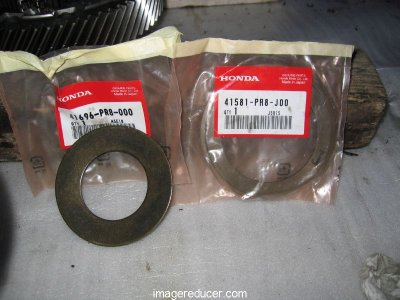All of the above is all well and good when the two examples in question are accelerating down a straightaway. Where it all gets sticky is when the turns arrive (at a race track).
Then, what's important is WHEN the shifts must occur. If the shift must be made in the middle of a corner, that's not good. If the car runs out of rpm as a corner looms ahead (with no time to up shift), that's not good. If the car does not reach 7,900rpm at the very end of the longest straight, that's not good. If the car falls below 6,000 rpm at the apex of the slowest corner, that's not good.
The track is the tie breaker (assuming Stirling Moss is driving both cars). As Peter Cunningham pointed out to me while he was running the NSX -- he carried several transmissions with him and chose according to need.
His inventory included all the possibilities... all the mixes between R&P and gear ratios. At Sears Point he used the JDM ratios with a 4.55 R&P. He was nervous about the 4.55 R&P because he had several of them fail -- but he used it because it was the best compromise for the 11 turns found at this 2.5 mile track.
Of course we can't change gearboxes depending on where we intend to drive today, can we?
This "compromise" is why (and how) I've come to embrace the JDM/4.55 combination for road & track (that would be a catchy name for a magazine).
Then, what's important is WHEN the shifts must occur. If the shift must be made in the middle of a corner, that's not good. If the car runs out of rpm as a corner looms ahead (with no time to up shift), that's not good. If the car does not reach 7,900rpm at the very end of the longest straight, that's not good. If the car falls below 6,000 rpm at the apex of the slowest corner, that's not good.
The track is the tie breaker (assuming Stirling Moss is driving both cars). As Peter Cunningham pointed out to me while he was running the NSX -- he carried several transmissions with him and chose according to need.
His inventory included all the possibilities... all the mixes between R&P and gear ratios. At Sears Point he used the JDM ratios with a 4.55 R&P. He was nervous about the 4.55 R&P because he had several of them fail -- but he used it because it was the best compromise for the 11 turns found at this 2.5 mile track.
Of course we can't change gearboxes depending on where we intend to drive today, can we?
This "compromise" is why (and how) I've come to embrace the JDM/4.55 combination for road & track (that would be a catchy name for a magazine).
Last edited:






